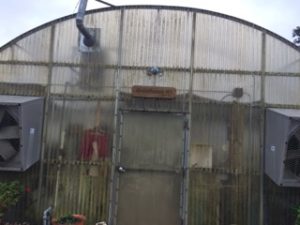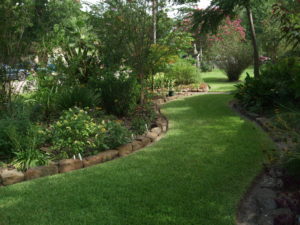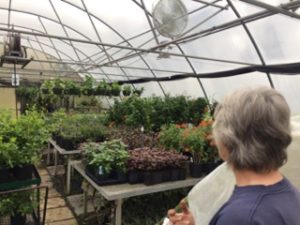
Welcome to Greenhouse 1!

The Greenhouse/Shade Area is a fascinating place where propagation and maintenance of plants takes place year long. Starting with a seed or cutting, in just a few short months the greenhouse crew produces a product ready for purchase in one of our plant sales. Plants are also grown and given to Landscape Solutions, Master Gardner Monthly Meeting drawings and as door prizes for Speakers Bureau participants.
The Joy of Testing New Plants

Test beds for this area
Getting to Know Greenhouse 1
by Phyllis McDonald, Master Gardener Propagation Specialist
Just exactly what goes on in Greenhouse One? Some would call it science, where we practice plant propagation; others might call it magic, like Keebler Elves in their hollow trees.
On cold winter mornings, most of the gardens at the extension office are dormant. The plants are resting, waiting for spring. However, in Greenhouse One, nothing is asleep. There is a plant sale in March and every species that is produced by the Master Gardeners must look its best.
Greenhouse One’s primary function is the propagation of flowering plants and succulents. Plants are provided for such activities as the Master Gardener plant sales, Landscape Solutions, county projects, and educational programs
Shortly after the sale in October, plant material was gathered before winter hit with force. Cuttings were thoughtfully made, placed in selected rooting medium and located on the mist table, where the cutting thrives in a moist, humid environment. Seeds that were gathered from the gardens were cleaned, treated, sown in trays and located on the seedling table where they are kept moist and warm until germination. Plants took root and began to grow. As they grew, each plantlet was potted, fertilized and perhaps potted again.
Open the door to Greenhouse One in January and your glasses will fog up. It may be in the 30s outside, but a balmy 80 in our greenhouse. As your glasses clear, you will be amazed at the beauty of the plants inside, the variety of species, and the sheer number of plants. Plants are everywhere—hanging from the frame, under the tables, on boards between tables, as well as covering every inch of table space.
Currently, the greenhouse is caring for approximately 2500 plants from 75 different species, not including the wide variety of succulents enveloping three tables.
As the weather moderates, some of the more hardy species are moved outside to an area called “The Corridor”. Plants here are hardened off to become ready for outside planting. Although no longer in the greenhouse, they remain watered, trimmed, pruned, trained, and closely monitored. Should the weather take a drastically cold dive, they are protected.
The majority of the current activity in Greenhouse One will be culminated at the spring plant sale. And, the Wednesday after the sale, workers in Greenhouse One will begin the cycle again, getting ready for October and the fall plant sale, as well as the many donations which will be requested over the summer.

Master Gardener Phyllis McDonald in Greenhouse 1

Succulents in Greenhouse 1